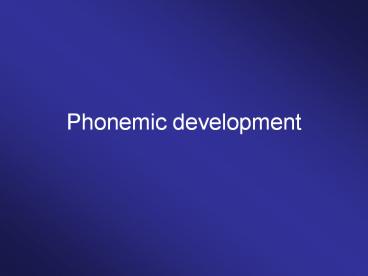Phonemic development - PowerPoint PPT Presentation
1 / 38
Title: Phonemic development
1
Phonemic development
2
Exemplar theory/view
attractor
/t/
/d/
3
Categorical perception
Continuous perception
Categorical perception
4
Categorical perception
p
b
b
d
Liberman 1957
5
Categorical perception
Like adult speakers of English, English
infants perceive the gradual transition from b
to t categorically.
Eimas et al. 1971
6
Categorical perception
Categorical perception is a unique human capacity
and restricted to language.
Eimas et al. 1971
7
Categorical perception
- Categorical perception also occurs in other
species. - Categorical perception is not restricted to
speech. - Categorical perception is not characteristic of
all speech sounds.
8
Phonetic assimilation
- Context-free strategies
- Context-bound strategies
9
Phonetic assimilation
ds glass bEd bread sek snake hn hand
da star
Reduction of consonant cluster
10
Phonetic assimilation
bn van dt that nEr there dk Jack d
b jam dEk check
Word-initial fricatives are replaced by stops
11
Phonetic assimilation
bOt pot do toe dI kiss
Voicing of word-initial stops
12
Phonetic assimilation
dat duck det gate zus shoes mts match
tb_at_dz cabbage
Fronting of consonants
13
Phonetic assimilation
nOp knob bt bad dOt dog duf stove
Devoicing of final obstruents
14
Phonetic assimilation
böt but gög big gök book gIg pig gOg
dog dOt dot gök duck gIk stick
Harmonization of initial consonants (if the word
ends in a velar consonant)
15
Motherese
- Exaggerated stress patterns, exaggerated
intonation - Many repetitions
- Many vocatives/attention getters
- Many questions
- Simple sentences and simple grammatical
constructions - Basic vocabulary
16
Fatherese
- Question-answer
- Request-response
- Focus of attention - response
17
Early words
18
Pragmatic development
- Language is an instrument. Language us used to
- express anger
- ask a question
- promise someone to do something
- warn somebody
19
Pragmatic development
- Language is learned in social interactions
involving three important components
- speaker
- hearer
- things and events talked about
20
Pragmatic development
- Bühler 1934 Organon Model
21
Pragmatic development
- dyadic interactions
22
Pragmatic development
9-months revolution Tomasello 1999
- Triadic interactions
23
Vocabulary development
12 13 First words 20 100-600
words 9-10 words a day 60 14,000
words 180 50,000 words
24
Vocabulary development
vocabulary development
25
Vocabulary development
What leads to the vocabulary spurt?
26
Vocabulary development
What leads to the vocabulary spurt?
27
Vocabulary development
- The vocabulary spurt begins when children
recognize the symbolic nature of language (i.e.
when they recognize that everything has a name. - The vocabulary development is trigged by advanced
articulatory skills.
28
Vocabulary development
10 11 12 13 14 15 16 daddy, mommy bye dog, hi, uh oh baby, ball, no eye, nose, banana, juice, shoe, kitty, bird, duck, car, book, balloon, bottle, night-night, woof, moo, ouch, baa baa, yum yum apple, cheese, ear, cracker, keys, bath, peekaboo, vroom, up, down, that grandpa, grandma, sock, hat, cat, fish, truck, boat, thank you, cup, spoon, back
29
Vocabulary development
- Words referring to people daddy, mommy, baby
- Words referring to animals dog, kitty, bird,
duck - Words referring to body parts eye, nose, ear
- Words referring to food banana, juice, apple,
cheese - Words referring to toys ball, balloon, book
- Words referring to cloths shoe, sock, hat
- Words referring to vehicles car, truck, boat
- Words referring to household objects bottle,
keys, bath, spoon - Words denoting routines bye, hi, uh oh,
night-night, no - Words denoting activities up, down, back
- Sound imitating words woof, moo, ouch, baa baa,
yum - Deictics that
30
Vocabulary development
Childrens early words function as speech acts
(i.e. there is no functional distinction between
words and utterances.
31
Vocabulary development
What do children need to understand in order to
learn words?
They need to understand the symbolic nature of
language.
32
Vocabulary development
What do children need to understand in order to
learn words?
33
Vocabulary development
see 1. I saw Peter. 2. I see what you
mean. run 1. She is running down the stairs.
2. She ran into Peter. car 1.
vehicle 2. toy have 1. She has a dog.
2. I have finished my work.
34
Vocabulary development
head of a department
head of a nail
header
flower head
body part
to head
head of a team
35
Vocabulary development
ball
balloon
ball
moon
orange
Partitioning of the conceptual space
36
Vocabulary development
doggy
dog
37
Vocabulary development
Word First referent overextensions
dog mooi ticktock baw mum fly fm wau-wau sch (Germ) dog moon watch ball horse fly worm sound of train dog cat, horse, rabbit, lion, tiger, all four-legged animals cakes, round marks on window, round shapes in books, round postmarks, letter O clock, gas meter, fire hose on spool, bath scale with round dial apples, grapes, eggs, squash, bell clapper, anything round cow, calf, pig, moose, all 4-legged animals specks of dirt, dust, all small insects, childs own toes, crumbs of bread, toad flies, ants, all small insects, heads of timothy grass all animals, toy dog, soft house, slippers, picture of old man in furs all moving machines
38
Vocabulary development
- Why do children overgeneralize word meanings?
- Hypothesis 1 Children are not yet able to
distinguish dogs from other animals. - Hypothesis 2 Childrens restricted vocabulary
forces them to overgeneralize words.































